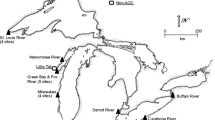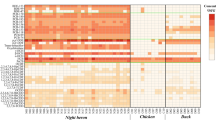Abstract
Colonially nesting aquatic birds can indicate site-specific contamination because they are high-level predators and dependent upon local resources during the breeding season. We compared persistent organochlorine concentrations in black-crowned night heron (Nycticorax nycticorax) eggs collected in 1992–93 among areas of known contamination (New York Harbor, Boston Harbor, Cape Cod, and Delaware Bay) and a reference site (Nantucket Island) in the northeastern United States (7–16 eggs/site). Total PCBs, p,p′-DDE, oxychlordane, heptachlor epoxide, and trans-nonachlor were detected in most eggs and were significantly higher in New York Harbor compared to all other sites (ANOVA on factor scores from the first principal component, which accounted for 75% of data variance, p < 0.0001). New York also had the highest contamination index (the number of Superfund sites within 20 km of the colony) among the sites. Nantucket, the reference site, had consistently low contamination in eggs, and the lowest contamination index. We conclude that black-crowned night heron eggs are useful indicators of site-specific persistent organochlorine contamination, as indexed by the number of nearby Superfund sites.
Similar content being viewed by others
Author information
Authors and Affiliations
Rights and permissions
About this article
Cite this article
Matz, ., Parsons, . Organochlorines in Black-Crowned Night Heron (Nycticorax nycticorax) Eggs Reflect Persistent Contamination in Northeastern US Estuaries. Arch Environ Contam Toxicol 46, 270–274 (2004). https://doi.org/10.1007/s00244-003-2265-9
Issue Date:
DOI: https://doi.org/10.1007/s00244-003-2265-9




